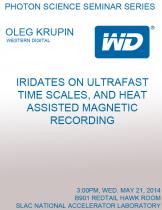Speaker: Oleg Krupin, Western Digital
Program Description
In the first part of the talk electronic and magnetization dynamics of iridates on ultrafast time scales will be presented and discussed at the example of Sr2IrO4. Sr2IrO4 is a narrow-gap Mott insulator with the crystal structure identical to La2CuO4 – the parent compound for 3d high-temperature superconductors (HTSC), and with a strong spin-orbit coupling (SOC) inherited from the heavy 5d Ir4+ ions. The ground state of Sr2IrO4 is given by an antiferro-ordered Jeff=1/2 state with a complex spin-orbital entangled structure. Contribution of spatially anisotropic orbital moments into the Jeff=1/2 state makes these states very distinct from an isotropic S=1/2 state. As a result, the interactions between the Jeff=1/2 states should strongly depend on the lattice geometry. Many exotic phases are predicted to exist originating from these anisotropic interactions. Surprisingly, it turns out that for the Sr2IrO4 crystal symmetry, the interactions of the magnetic moments to a large extent can still be described within the Heisenberg model, barring Hund’s rule coupling. A compelling outcome of this is that a novel Heisenberg antiferromagnet emerges, with an isostructural lattice and similar low-energy excitation spectra to the HTSCs, but with strong SOC and drastically different spatial localization of the d-orbitals. This may serve as a novel platform to study physics related to emergence of HTSC. Here we present results of an experiment devoted to electronic and magnetic excitations in the Jeff=1/2 phase of Sr2IrO4, in which we followed the evolution of the electronic and magnetic systems after an optical excitation of electrons across the Mott gap using resonant hard x-ray diffraction at the iridium L3 edge and measuring the transient change of optical reflectivity.
In the second part of the talk, emerging technology of heat-assisted magnetic recording (HAMR) will be discussed. HAMR is in focus of current research as the most promising approach to achieve extremely high density of magnetic recording in hard disk drives. Further scaling of the areal density in HDD requires keeping balance between thermal stability of magnetic grains and their writability. In HAMR the media is firstly heated to reduce magnetic anisotropy of the magnetic grains during recording process, and next it is cooled down to room temperature to provide thermal stability of recorded magnetic states for long-term data storage. Tailoring this dynamic writing process for achieving areal density beyond 1Tb/in2 will be considered, requirements and challenges for optimization of HAMR head and media will be overviewed and discussed.





